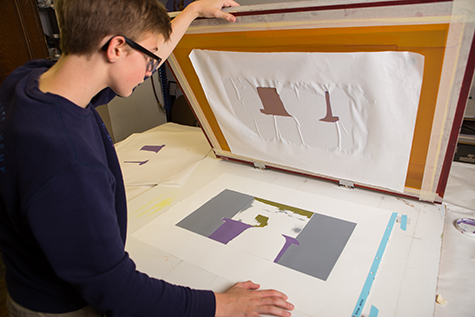The Important Overview to Comprehending Screen Printing and Its Versatile Uses
Screen printing has a rich background that goes back to old times, progressing into an advanced technique utilized across different markets today. This guide discovers the ins and outs of the screen printing process, describing its applications in fashion, advertising and marketing, and home style - 10:9 Design Screen Printing. Understanding these basics can open innovative possibility for both imaginative and business jobs. The adhering to areas will reveal crucial tips and methods to boost one's screen printing ventures
The History of Screen Printing
Although screen printing has roots that map back centuries, its evolution reflects the creative and technical innovations of various cultures. Coming from ancient China, the strategy was at first used for decorating fabrics and later spread to Japan, where it ended up being integral to Ukiyo-e woodblock printing. The technique moved to Europe in the 18th century, where it acquired appeal among craftsmens and industrial printers. The innovation of photo solution in the 20th century revolutionized screen printing, permitting for more complex styles and better performance. Musicians like Andy Warhol better pushed its appeal, using the medium to create iconic jobs that blended commercialism and art. By the late 20th century, screen printing had established itself as a flexible method, utilized in style, marketing, and art. Today, it remains to develop, integrating electronic innovation and expanding its applications across different markets.
The Screen Printing Refine Explained
Screen printing transforms creative visions right into tangible layouts through a series of specific steps. Originally, an image is produced and afterwards transferred onto a screen, generally made of great mesh material stretched over a structure. A light-sensitive emulsion is applied to the screen, which is revealed to light, setting in locations not covered by the image. After rinsing the unhardened emulsion, a pattern is formed.
Next, the screen is placed over the substratum, whether it be fabric, paper, or one more product. Ink is after that pushed through the open areas of the pattern using a squeegee, transferring the design onto the substratum listed below. This procedure can be duplicated for numerous shades, requiring separate displays for each and every color. The printed product is treated using warmth to ensure the ink adheres appropriately, resulting in a long lasting, vibrant layout ready for usage.
Kinds of Screen Printing Techniques

In addition, specialty methods, such as discharge screen printing, get rid of color from the textile to create softer prints, while aluminum foil screen printing applies metal aluminum foil to achieve a shiny surface (10:9 Design Screen Printing Texas). Each method supplies distinctive characteristics, satisfying different imaginative needs and production scales, ultimately expanding the possibilities within the screen printing domain
Applications of Screen Printing in Numerous Industries

Furthermore, the signage and advertising fields utilize screen printing for producing captivating display screens and banners. This method allows for strong shades and intricate layouts that record focus. In electronic devices, screen printing is employed for using conductive inks to circuit card, crucial for part connections. Moreover, the home décor market accepts screen printing to generate unique designs on textiles and wall art. In general, screen printing acts as a crucial device across diverse fields, enhancing items with customized and visually enticing graphics.
Tips for Effective Screen Printing Projects
While carrying out a screen printing task, mindful focus to information can significantly improve the final end result. Picking high-grade materials is crucial; this includes the screen, inks, and substratums. Using ideal mesh counts can influence ink deposition and detail resolution. Prep work is equally vital; extensive cleaning of screens and proper exposure times guarantee crisp prints.
Next, accurate enrollment is essential for multi-color prints. Utilizing positioning tools can assist achieve precise layering. Furthermore, screening prints on scrap materials check out here before production aids determine potential issues without throwing away resources.

Often Asked Inquiries
What Products Are Ideal for Screen Printing on Textile?
Cotton and polyester blends are ideal for screen printing on fabric because of their durability and ink absorption. Furthermore, specialty textiles like silk or canvas can create one-of-a-kind textures and coatings, improving the total design high quality.
Just how Do I Clean and Maintain Screen Printing Equipment?
To clean up and preserve screen printing equipment, one should on a regular basis wash displays with appropriate solvents, examine squeegees for wear, oil moving components, and shop all items in a dry, dust-free atmosphere to prolong their lifespan.
What Are the Environmental Impacts of Screen Printing?
Screen printing can have considerable environmental impacts, consisting of chemical waste from solvents and inks, water use throughout cleaning procedures, and power intake. Sustainable techniques and environment-friendly materials are crucial for minimizing these negative impacts.
Can Screen Printing Be Done in your home Properly?
Screen printing can be effectively done at home with the appropriate products and methods. Hobbyists can create high quality prints, though success depends on their ability level, devices, and understanding of the procedure entailed.
What Are the Costs Related To Beginning a Screen Printing Company?

Beginning a screen printing service includes costs for tools, materials, and office. Initial expenses normally vary from a few hundred to several thousand bucks, relying on the range, top quality of equipment, and wanted manufacturing capacity.
Screen printing has an abundant background that dates back to ancient times, advancing right into an innovative technique utilized across numerous markets today. One more technique, rotating screen printing, utilizes round displays, helping with continual printing on material rolls, therefore improving efficiency for large-scale manufacturings. Furthermore, specialized strategies, such as discharge screen printing, remove color from the fabric to produce custom sandwich board signs softer prints, while aluminum foil screen printing uses metal foil to accomplish a glossy finish. In the style market, screen printing is extensively made use of to produce dynamic designs on apparel, making it possible for brands to display their distinct designs. Cotton and polyester blends are suitable for screen printing on textile due to their toughness and ink absorption.